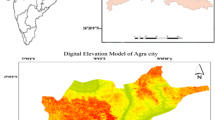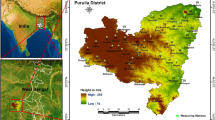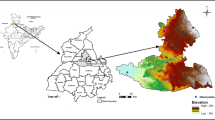Abstract
Indiscriminate urbanization and population explosion have put tremendous stress on groundwater resource of Paschim Medinipur, an agriculture-dominated area. In this aspect delineation of potential groundwater recharge zones can play a crucial role in the long run. Initially, ten different influencing factors i.e., geology, geomorphology, rainfall, aquifer material, drainage density, soil type, lineament and fault density, slope, elevation and Land use land cover (LULC) are integrated into ArcGIS environment to generate the potential groundwater recharge zones (GWRZ) within the study area. The final GWRZ was categorized into three classes namely high, medium and low where about 33% (3152.46 sq. km) of the total area fall under high GWRZ, about 25% (2379.02 sq. km) is covered by medium GWRZ and low GWRZ covers about 39.96% (3743.16 sq. km) of the study area. Predicted model is validated with water table fluctuation data collected from 87 monitoring wells by implementing Success Rate Curve (SRC) and the Prediction Rate Curve (PRC) where an accuracy of 81% prediction is observed. The study of WTF trend for past 23 years using the multiplicative model of time series shows a significant declining trend in-depth to water-table. Based on the model outcome various recharge structures are recommended in the specific locations of the study area which may be further confirmed through field investigation before implementation. Outcomes of the present study can be a first-hand tool to the policymakers, planners and government officials for sustainable water resource management in the study area.








Similar content being viewed by others
References
Bhuiyan C (2015) An approach towards site selection for water banking in unconfined aquifers through artificial recharge. J Hydrol 523:465–474. https://doi.org/10.1016/j.jhydrol.2015.01.052
Bouwer H (2000) Integrated water management: emerging issues and challenges. Agric Water Manag 45(3):217–228. https://doi.org/10.1016/s0378-3774(00)00092-5
CGWB (2014) Ground water year book of West Bengal & Andaman & Nicobar Islands (2013–2014). Technical Report: Series ‘D’. Central Ground Water Board, Ministry of Water Resources (Government of India). https://www.cgwb.gov.in/Regions/GW-year-Books/GWYB-2013-14/West%2520Bengal%2520GWYB%252013-14.pdf. Accessed on: Jan 2018
CGWB (2016a) Ground water year book of West Bengal & Andaman & Nicobar Islands (2014–2015). Technical Report: Series ‘D’. Central Ground Water Board, Ministry of Water Resources (Government of India), https://www.cgwb.gov.in/Regions/GW-year-Books/GWYB-2014-15/GWYB%25202014-15(WB%2520AND%2520AN).pdf. Accessed on: Jan 2018
CGWB (2016b) Ground water year book of West Bengal & Andaman & Nicobar Islands (2014–2015) Technical Report: Series ‘D’. Central Ground Water Board, Ministry of Water Resources (Government of India). https://www.cgwb.gov.in/Regions/GW-year-Books/GWYB-2015-16/GWYB%2520ER%25202015-16.pdf. Accessed on: Jan 2018
CGWB (2017) Ground water year book of West Bengal & Andaman & Nicobar Islands (2014–2015) Technical Report: Series ‘D’. Central Ground Water Board, Ministry of Water Resources (Government of India). https://cgwb.gov.in/Regions/GW-year-Books/GWYB-%25202016-17/WB%2520&%2520Andaman.pdf. Accessed on: Jan 2018
Chatterjee RS, Bhattacharya AK (1995) Delineation of the drainage pattern of a coal basin related inference using satellite remote sensing techniques. Asia Pac Remote Sens J 1:107–114
Chezgi J, Pourghasemi HR, Naghibi SA, Moradi HR, Kheirkhah Zarkesh M (2015) Assessment of a spatial multi-criteria evaluation to site selection underground dams in the Alborz Province. Iran Geocarto Int 31(6):628–646. https://doi.org/10.1080/10106049.2015.1073366
Chowdhury A, Jha MK, Chowdary VM (2009) Delineation of groundwater recharge zones and identification of artificial recharge sites in West Medinipur district, West Bengal, using RS, GIS and MCDM techniques. Environ Earth Sci 59(6):1209–1222. https://doi.org/10.1007/s12665-009-0110-9
Chung CJF, Fabbri AG (2003) Validation of Spatial Prediction Models for Landslide Hazard Mapping. Nat Hazards 30(3):451–472. https://doi.org/10.1023/b:nhaz.0000007172.62651.2b
Dam WL (2005) Modern Groundwater Exploration: Discovering New Water Resources in Consolidated Rocks Using Innovative Hydrogeologic Concepts, Exploration, Drilling, Aquifer Testing, and Management Methods. Environ Prac 7(4):274–276. https://doi.org/10.1017/S1466046605220409
Dawoud MA, Darwish MM, El-Kady MM (2005) GIS-based groundwater management model for western Nile delta. Water Resour Manag 19(5):585–604
De Vries JJ, Simmers I (2002) Groundwater recharge: an overview of processes and challenges. Hydrogeol J 10(1):5–17. https://doi.org/10.1007/s10040-001-0171-7
DPD Govt. of West Bengal 2011. District Human Development Report: Paschim Medinipur, Development & Planning Department, Government of West Bengal. https://www.wbpspm.gov.in/SiteFiles/Publications/13_21062017103239.pdf (Accessed on Mar 2019)
El-Baz F, Himida I (1995) Groundwater potential of the Sinai Peninsula. Egypt, Project Summary, Agency for International Development(AID), Cairo, Egypt
El-Kadi AI, Oloufa AA, Eltahan AA, Malik HU (1994) Use of a Geographic Information System in Site-Specific Ground-Water Modelinga. Ground Water 32(4):617–625. https://doi.org/10.1111/j.1745-6584.1994.tb00897.x
Foster SSD, Chilton PJ (2003) Groundwater: the processes and global significance of aquifer degradation. Philos T R Soc B 358(1440):1957–1972. https://doi.org/10.1098/rstb.2003.1380
Ganapuram S, Kumar GTV, Krishna IVM, Kahya E, Demirel MC (2009) Mapping of groundwater potential zones in the Musi basin using remote sensing data and GIS. Adv Eng Softw 40(7):506–518. https://doi.org/10.1016/j.advengsoft.2008.10.001
Gogu R, Carabin G, Hallet V, Peters V, Dassargues A (2001) GIS-based hydrogeological databases and groundwater modelling. Hydrogeol j 9(6):555–569. https://doi.org/10.1007/s10040-001-0167-3
Harinarayana P, Gopalakrishna GS, Balasubramanaian A (2000) Remote sensing data for groundwater development and management in Keralapura watersheds of Cauvery basin, Karnataka. India Indian Mineral 34(2):11–17
Healy RW, Cook PG (2002) Using groundwater levels to estimate recharge. Hydrogeol J 10(1):91–109. https://doi.org/10.1007/s10040-001-0178-0
Ibrahim-B K, Ahmed SA (2016) Geospatial technology for delineating groundwater potential zones in Doddahalla watershed of Chitradurga district, India Egypt. J Remote Sens Sp Sci 19:223–234
Jaiswal RK, Mukherjee S, Krishnamurthy J, Saxena R (2003) Role of remote sensing and GIS techniques for generation of groundwater prospect zones towards rural development–an approach. Int J Remote Sens 24(5):993–1008. https://doi.org/10.1080/01431160210144543
Kaliraj S, Chandrasekar N, Magesh NS (2013) Identification of potential groundwater recharge zones in Vaigai upper basin, Tamil Nadu, using GIS-based analytical hierarchical process (AHP) technique. Arab J Geosci 7(4):1385–1401. https://doi.org/10.1007/s12517-013-0849-x
Kamaraju MVV, Bhattacharya A, Reddy GS, Rao GC, Murthy GS, Rao TCM (1995) Groundwater potential evaluation of West Godavari District, Andhra Pradesh State India -A GIS approach. Ground Water 34(2):318–325
Kaur H, Gupta S, Parkash S, Thapa R (2018) Knowledge driven method: A tool for landslide susceptibility zonation (LSZ). Geol Ecol Landscapes. https://doi.org/10.1080/24749508.2018.1558024
Kaur H, Gupta S, Parkash S, Thapa R (2018) Application of Geospatial technologies for multi-hazard mapping and characterization of associated risk at local scale. Ann. GIS 1:33–46. https://doi.org/10.1080/19475683.2018.1424739
Kaur H, Gupta S, Parkash S, Thapa R, Gupta A, Khanal GC (2019) Evaluation of landslide susceptibility in a hill city of Sikkim Himalaya with the perspective of hybrid modelling techniques. GIS, Ann. https://doi.org/10.1080/19475683.2019.1575906
Kaur H, Gupta S, Parkash S, Thapa R, Mandal R (2017) Geospatial modelling of flood susceptibility pattern in a subtropical area of West Bengal India. Environ Earth Sci 76(339):1–22. https://doi.org/10.1007/s12665-017-6667-9
Kazakis N, Voudouris KS (2015) Groundwater vulnerability and pollution risk assessment of porous aquifers to nitrate: modifying the drasticmethod using quantitative parameters. J Hydrol 525:13–25. https://doi.org/10.1016/j.jhydrol.2015.03.035
Krishnamurthy J, Venkatesh Kumar N, Jayraman V, Manivel M (1996) An approach to demarcate groundwater potential zones through remote sensing and a geographical information system. Int J Remote Sens 17(10):1867–1884. https://doi.org/10.1080/01431169608948744
Kukillaya JP, Padmanbhan K, Krishnan E (1999) Use and limitations of short and medium duration pumping tests in understanding hard rock aquifers—an example from Kerala. J Geol Soc India 54(3):267–277
Lee CH, Yeh HF, Chen JF (2007) Estimation of groundwater recharge using the soil moisture budget method and the base-flow model. Environ Geol 54(8):1787–1797. https://doi.org/10.1007/s00254-007-0956-7
Magesh NS, Chandrasekar N, Soundranayagam JP (2012) Delineation of groundwater potential zones in Theni district, Tamil Nadu, using remote sensing GIS and MIF techniques. Geosci Front 3(2):189–196. https://doi.org/10.1016/j.gsf.2011.10.007
Magesh NS, Jitheshlal KV, Chandrasekar N, Jini KV (2013) Geographical information system-based morphometric analysis of Bharathapuzha river basin, Kerala India. Appl Water Sci 3(2):467–477. https://doi.org/10.1007/s13201-013-0095-0
Nag SK, Ray S (2014) Deciphering Groundwater Potential Zones Using Geospatial Technology: A Study in Bankura Block I and Block II, Bankura District West Bengal. Arab J Sci Eng 40(1):205–214. https://doi.org/10.1007/s13369-014-1511-y
Naghibi SA, Pourghasemi HR, Dixon B (2015) GIS-based groundwater potential mapping using boosted regression tree, classification and regression tree, and random forest machine learning models in Iran. Environ Monit Assess. https://doi.org/10.1007/s10661-015-5049-6
Narendra K, Rao KN, Latha PS (2013) Integrating Remote Sensing and GIS for Identification of Groundwater Prospective Zones in the Narava Basin Visakhapatnam Region, Andhra Pradesh. J Geol Soc India 81:248–260
Preeja KR, Joseph S, Thomas J, Vijith H (2011) Identification of Groundwater Potential Zones of a Tropical River Basin (Kerala, India) Using Remote Sensing and GIS Techniques. J Indian Soc Remote 39(1):83–94. https://doi.org/10.1007/s12524-011-0075-5
Rajaveni SP, Brindha K, Elango L (2017) Geological and geomorphological controls on groundwater occurrence in a hard rock region. Appl Water Sci 7(3):1377–1389. https://doi.org/10.1007/s13201-015-0327-6
Ramaiah SN, Gopalakrishna GS, Vittala SS, Muhammad N (2012) Geomorphological Mapping for Identification of Ground Water Potential Zones in Hard Rock Areas Using Geo-spatial Information – A Case Study in Malur Taluk, Kolar District, Karnataka India. Nat Environ Pollut Technol J 3:369–376
Riad PH, Billib MH, Hassan AA, Omar MA (2011) Water scarcity management in a semi-arid area in Egypt: overlay weighted model and Fuzzy logic to determine the best locations for artificial recharge of groundwater Nile Basin. Water Sci Eng J 4(1):24–35
Samadder RK, Kumar S, Gupta RP (2011) Paleochannels and their potential for artificial groundwater recharge in the western Ganga plains. J Hydrol 400(1–2):154–164. https://doi.org/10.1016/j.jhydrol.2011.01.039
Saraf AK, Choudhury PR (1998) Integrated remote sensing and GIS for groundwater exploration and identification of artificial recharge sites. Int J Remote Sens 19(10):1825–1841. https://doi.org/10.1080/014311698215018
Scanlon BR, Faunt CC, Longuevergne L, Reedy RC, Alley WM, McGuire VL, McMahon PB (2012) Groundwater depletion and sustainability of irrigation in the US High Plains and Central Valley. Proc Nation Acad Sci 109(24):9320–9325. https://doi.org/10.1073/pnas.1200311109
Sedhuraman M, Revathy SS, Suresh BS (2014) Integration of Geology and Geomorphology for Groundwater Assessment using Remote Sensing and GIS Techniques. IJIRSET 3:3
Selvam S, Manimaran G, Sivasubramanian P, Balasubramanian N, Seshunarayana T (2014) GIS-based evaluation of water quality index of groundwater resources around Tuticorin coastal city. South India. Environ Earth Sci 71(6):2847–2867. https://doi.org/10.1007/s12665-013-2662-y
Senanayake IP, Dissanayake DMDOK, Mayadunna BB, Weerasekera WL (2016) An approach to delineate groundwater recharge potential sites in Ambalantota, Sri Lanka using GIS techniques. Geosci Front 7(1):115–124. https://doi.org/10.1016/j.gsf.2015.03.002
Shaban A, Khawlie M, Ab M, Abdallah C (2005) Use of remote sensing and GIS trecharge potential zones: the case of Occidental Lebanon. Hydrogeol J 14(4):433–443. https://doi.org/10.1007/s10040-005-0437-6
Shahid S, Nath SK (1999) GIS integration of remote sensing and electrical sounding data for hydrogeological exploration. JOSH 2(1):1–12
Sikdar PK, Chakraborty S, Adhya E, Paul PK (2004) Land use/ land cover changes and groundwater potential zoning in and around Raniganj coal mining area, Bardhaman District, West Bengal: A GIS and remote sensing approach. JOSH 4(2):1–24
Singh A (2015) Poor quality water utilization for agral production: An environmental perspective. Land Use Policy 43:259–262. https://doi.org/10.1016/j.landusepol.2014.11.015
Singh A, Kumar S, Chakrapani GJ (2015) A modified-DRASTIC model (DRASTICA) for assessment of groundwater vulnerability to pollution in an urbanized environment in Lucknow India. Environ Earth Sci 74(7):5475–5490. https://doi.org/10.1007/s12665-015-4558-5
Solomon S, Quiel F (2005) Groundwater study using remote sensing and geographic information systems (GIS) in the central highlands of Eritrea. Hydrogeol J 14(5):729–741. https://doi.org/10.1007/s10040-005-0477-y
Taheri K, Gutiérrez F, Mohseni H, Raeisi E, Taheri M (2015) Sinkhole susceptibility mapping using the analytical hierarchy process (AHP) and magnitude–frequency relationships: A case study in Hamadan province. Iran Geomorphol 234:64–79. https://doi.org/10.1016/j.geomorph.2015.01.005
Taheri K, Taheri M, Parise M (2016) Impact of intensive groundwater exploitation on an unprotected covered karst aquifer: a case study in Kermanshah Province, western Iran. Environ Earth Sci. https://doi.org/10.1007/s12665-016-5995-5
Thapa R, Gupta S, Kaur H (2017a) Delineation of potential fluoride contamination zones in Birbhum, West Bengal, India, using remote sensing and GIS techniques. Arab J Geosci 10(527):1–18. https://doi.org/10.1007/s12517-017-3328-y
Thapa R, Gupta S, Reddy DV (2017) Application of geospatial modelling technique in delineation of fluoride contamination zones within Dwarka Basin, Birbhum India. Geosci Front 8(5):1105–1114. https://doi.org/10.1016/j.gsf.2016.11.006
Thapa R, Gupta S, Guin S, Kaur H (2018) Sensitivity analysis and mapping the potential groundwater vulnerability zones in Birbhum district, India: A comparative approach between vulnerability models. Water Sci 32(1):44–66. https://doi.org/10.1016/j.wsj.2018.02.003
Thapa R, Gupta S, Gupta A, Reddy DV, Kaur H (2017) Use of geospatial technology for delineating groundwater potential zones with anemphasis on water-table analysis in Dwarka River basin, Birbhum India. Hydrogeol J 26(3):899–922. https://doi.org/10.1007/s10040-017-1683-
Thapa R, Gupta S, Kaur H, Mandal R (2018) Assessment of manganese contamination in groundwater using frequency ratio (FR) modeling and GIS: a case study on Burdwan district, West Bengal India. MESE 4(1):161–174. https://doi.org/10.1007/s40808-018-0433-11
Thapa R, Gupta S, Kaur H, Rajak S (2018) Search for potential iron contamination zones in Burdwan district: an approach through fuzzy logic. Water Resour. Manag, Sustain. https://doi.org/10.1007/s40899-018-0277-x
Thapa R, Gupta S, Reddy DV, Kaur H (2018) Comparative evaluation of water quality zonation within Dwarka River Basin India. Hydrolog Sci J 63(4):583–595. https://doi.org/10.1080/02626667.2018.1445255
Thapa R, Gupta S, Gupta A, Reddy DV, Kaur H (2018) Geochemical and geostatistical appraisal of fluoride contamination: An insight into the Quaternary aquifer. Sci Total Environ 640–641(2018):406–418. https://doi.org/10.1016/j.scitotenv.2018.05.360
Thapa R, Gupta S, Kaur H (2017) Delineation of potential fluoride contamination zones in Birbhum, West Bengal, India, using remote sensing and GIS techniques. Arabian J Geosci 10:527. https://doi.org/10.1007/s12517-017-3328-y
Tiwari VM, Wahr J, Swenson S (2009) Dwindling groundwater resources in northern India, from satellite gravity observations. Geophys Res Lett. https://doi.org/10.1029/2009gl039401
Turker U, Alsalabi BS, Rızza T (2013) Water table fluctuation analyses and associated empirical approach to predict spatial distribution of water table at Yesilkoy/AgiosAndronikos aquifer. Environ Earth Sci 69:63–75. https://doi.org/10.1007/s12665-012-1934-2
Venetis C (1971) Estimation of unconfined ground water flow to ditches. J Hydrol 13:338–342. https://doi.org/10.1016/0022-1694(71)90252-6
Vijith H (2007) Groundwater potential in the hard rock terrain of western ghats: A case study from Kottayam district, Kerala using resourcesat (IRS-P6) data and GIS techniques. J Indian Soc Remote 35(2):163–171. https://doi.org/10.1007/bf02990780
Yeh HF, Cheng YS, Lin HI, Lee CH (2016) Mapping groundwater recharge potential zone using a GIS approach in Hualian River. Taiwan Sustain Environ Res 26(1):33–43. https://doi.org/10.1016/j.serj.2015.09.005
Yeh HF, Lee CH, Hsu KC, Chang PH (2008) GIS for the assessment of the groundwater recharge potential zone. Environ Geol 58(1):185–195. https://doi.org/10.1007/s00254-008-1504-9
Zaidi FK, Kassem OMK, Al-Bassam AM, Al-Humidan S (2014) Factors Governing Groundwater Chemistry in Paleozoic Sedimentary Aquifers in an Arid Environment: A Case Study from Hail Province in Saudi Arabia. Arab J Sci Eng 40(7):1977–1985. https://doi.org/10.1007/s13369-014-1534-4
Acknowledgements
The authors are very grateful to the BRNS, Department of Atomic Energy, India for financial assistance in the project (36(4)/14/23/2017-BRNS/36194 dated 08/12/2017) and also acknowledge DST, Govt. of India for providing financial support to set up a sophisticated laboratory in the Department of Environmental Science under FIST programme. The authors would also like to thank Central Ground Water Board, Survey of India and Geological Survey of India for their help and support.
Author information
Authors and Affiliations
Corresponding author
Additional information
Publisher's Note
Springer Nature remains neutral with regard to jurisdictional claims in published maps and institutional affiliations.
Electronic supplementary material
Below is the link to the electronic supplementary material.
Rights and permissions
About this article
Cite this article
Thapa, R., Gupta, S., Haque, M.I. et al. Application of geospatial modeling in deciphering groundwater recharge site and structures in Paschim Medinipur district, India. Sustain. Water Resour. Manag. 6, 79 (2020). https://doi.org/10.1007/s40899-020-00442-3
Received:
Accepted:
Published:
DOI: https://doi.org/10.1007/s40899-020-00442-3




